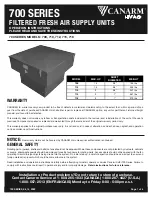
© Munters AB, 2013
7
Before activating the electrical supply to the machine
by turning the isolator switch to position On, a series of
checks must be made:
•
check that the voltage and frequency of the
power source correspond to those indicated in the
equipment technical data and electrical diagram;
•
check that the supply cables and the conductor
providing external protection are correctly
connected;
•
check that the connections in the control and power
circuits are properly tight;
•
check that the intensity of the short-circuit expected
at the connection terminals is compatible with the
breaking power of the protection switch upstream of
the electrical panel;
•
check that the protection devices (fuses,
magnetothermic switches) are correctly sized;
•
check that the phases are connected in the correct
order: check that the fan rotates in the direction of the
arrow shown on the driven pulley.
Equipotential protection circuit
To create effective protection against the risk of
electrocution, the outer protection conductor must be
connected to terminal PE inside an electrical panel.
For correct sizing of the protection conductors, see
following requirements:
•
phase conductor up to 16 mm²: section of the
protection conductor equal to the section of the
supply conductor;
•
phase conductor between 16 and 35 mm²: section
of protection conductor equal to 16 mm²;
•
phase conductor over 35 mm²: section of protection
conductor equal to at least half the section of the
supply conductor.
When connecting all the metal masses to
the earth system, check that there are no
insulating elements between the various
conductive masses (metal parts). The system must not
be put into operation unless the equipotentiality of the
masses and the connection to the earth system have
previously been checked.
Protection against contact voltages
The choice of device to protect the electrical system must
be made in such a way as to ensure the safe intervention
of the main automatic switches and any differential
devices linked to them. For an appropriate choice of the
type of protection for the machine’s supply line, taking
into account whether the distribution system is TT or TN,
it is advisable to consult an electrical systems designer.
3.5 TESTS anD chEckS bEforE STarTuP
Before startup, it is extremely important to carry out
a very careful check of the fan, in order to prevent
malfunctions and/or accidents.
In particular, perform the following operations.
Equipotential protection circuit:
•
check the fan visually, verifying that there are no
particular mechanical irregularities or foreign bodies
inside the structure;
•
check that the protective structures (fixed guards
made of metal mesh) are correctly positioned and
fixed;
•
check that the emergency stop function actuator
operates correctly.
checking the electrical system:
•
check that the supply conductors are properly fixed
to the terminals of the isolating switch;
•
check the connections of the conductors in the
equipotential circuit;
•
check that the guards inside the electrical panel are
correctly positioned and fixed;
•
check that the safety devices are receiving power
and are active, and check their effectiveness.
After this series of checks has been carried out, the fan is
ready for its first startup.
!
!
Tension the belt after three days of
operation: improper tension will lead
to premature wear on the transmission
devices.
!
Keep motor body clean. Dust deposit on
motor body will lead to overheating and
failure of bearings and motor itself. Do
not use water for motor cleaning. Use compressed
air only. Water spraying will cause rust inside the
bearings and lead to their failure.
Summary of Contents for ED24
Page 2: ......


































